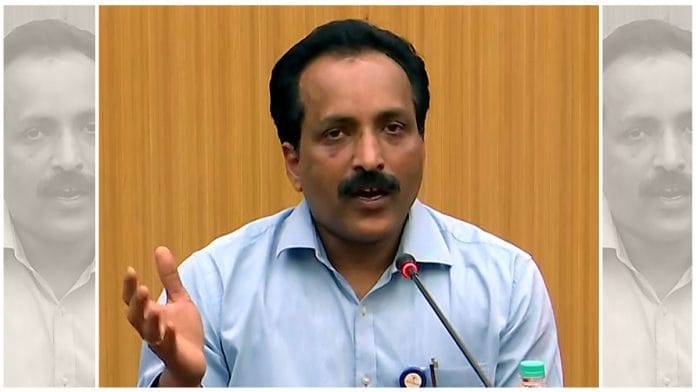New Delhi: From satellite launches to tests for India’s first manned mission to the Moon, the Indian Space Research Organisation (ISRO) has a packed calendar for the second half of the year.
Speaking on the sidelines of the third Annual India Space Congress in Delhi Wednesday, ISRO chief S. Somanath said, “The rest of 2024 is going to be hectic. We have three tests for Gaganyaan this year, as well as the launch of the NISAR. We will try to pack everything in the next few months.”
Detailing the launch calendar for the rest of the year, Somanath said that the GSAT-N2, formerly known as GSAT-20, is set to be launched on board SpaceX’s Falcon-9 launcher around August. GSAT-N2 aims to provide a low-cost Ka-Ka band (a range of the electromagnetic spectrum) high-throughput satellite to enhance broadband services and in-flight connectivity across the country.
The space agency is also preparing to launch India’s partnership mission with the US’s National Aeronautics and Space Administration (NASA), NISAR (NASA-ISRO Synthetic Aperture Radar), which is likely to take at least two months. Somanath said Wednesday that a part of the satellite — a deployable antenna — had to be sent back to NASA’s Jet Propulsion Laboratory for minor modifications.
The mission was initially due for launch in March this year but was delayed because of the error spotted in the antenna.
“A part of the satellite, the deployable antenna, is a US-company-supplied item. They have to make some corrections. It is likely to come back by 10 July. Once the antenna comes back, it will have to be integrated with the satellite and go through the test programme,” said Somanath.
Three tests for India’s first human spaceflight mission, Gaganyaan, are also lined up this year.
This year, the space agency will undertake a test flight, a pad abort test and an unmanned mission in preparation for Gaganyaan. The three-day mission, likely to take place in 2025, will see three astronaut designates launched into a low-Earth orbit of 400 km and brought back safely to Earth.
Somanath confirmed that the space agency is also ready to take the leap towards India’s next lunar mission, which aims to bring back samples from the Moon. The Space Docking Experiment or Spadex is an essential segment of the upcoming Chandrayaan-4 mission. ISRO will be launching two spacecraft — Chaser and Target — to engage in a complex and autonomous docking experiment in-orbit.
The aim of this demonstration will be to showcase ISRO’s capabilities in space navigation and robotics.
“We are hoping to launch Spadex by December,” he said.
Long-term plans
India is also working on a long-term plan under its ‘Vision 2047’, which has laid down a detailed plan for the country’s space programme for the next 25 years.
Somanath said the focus of the programme is to set up the Bharatiya Antariksh Station — India’s very own space station — expected to come up by 2035. The space agency aims to launch the first module, a basic version of the station, by 2028.
The space station will be placed in a low Earth orbit, designed to accommodate two to four astronauts in space. At present, only the US, China and Russia have sent space stations into orbit. India will become the fourth country with an independent station in space.
Somanath said the space station, with its docking facilities, will enable ISRO to carry out more complicated interplanetary space missions, including lunar missions where samples can be brought back to Earth for experiments.
Speaking to ThePrint, a senior ISRO scientist explained that the Chandrayaan-4 mission will depend greatly on making pit stops at the docking facilities during the course of the mission.
“The mission will be undertaken in parts, and during the course of the spacecraft’s travel, it will have to use the docking facilities of the space station. The primary design for the space station is ready, and undergoing some assessments and reviews,” the scientist said, requesting anonymity.
Apart from these high-priority projects, the space agency is also working on big-ticket missions including the Venus Mission — unofficially called Shukrayaan — and the Mars Orbiter Mission-2.
Officials working on the Venus Mission confirmed to ThePrint that the mission has received the required approvals from the government.
“Our priority over the next two years is going to be on the space station and the lunar return missions. Work on the Venus and Mars missions will progress parallelly but that is not our priority at the moment,” Somanath said.
(Edited by Rohan Manoj)
Also read: ISRO’s reusable launch vehicle, made to cut down mission costs, set for 3rd test landing this week






